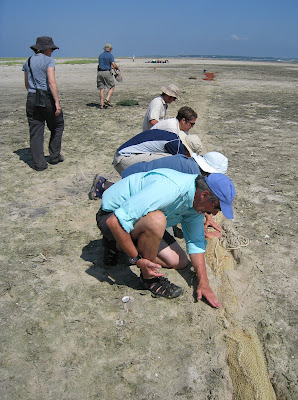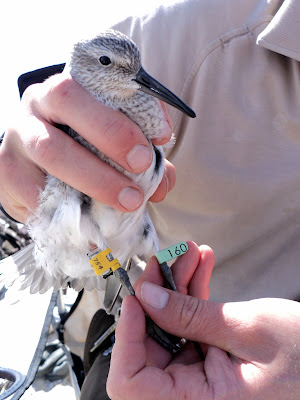Furl, smear, jiggle, twinkle and fire. It’s all in a day of red knot banding.
At Monomoy National Wildlife Refuge, the day began with a crisp ocean breeze as we, our coworkers, partners and volunteers, hauled several hundred pounds of field equipment to our boats. We were heading out to Minimoy Island to capture red knots, and everyone, especially first-timer Susi, was very excited!
“I was in learning mode, fumble fingers and all,” Susi said. “Then orders started to fly, and I really got lost.”
Capturing red knots is no easy task, even with a seasoned, experienced crew leader. At Monomoy Refuge, we use cannon nets, large explosive driven nets that allows us to capture a large number of birds at the same time.
The time and height of the tide, weather conditions, and disturbances in the area, including predatory falcons, are all factors that influence how red knots are using a particular site on a particular day. For example, the first day was beautiful, but no birds would come near the net; the second was cold, windy and even stormy, but the red knots showed! Our task is to anticipate all these variables when we set the net to increase our chances of a successful catch.
 |
| The trapping crew finishes camouflaging a net with a thin layer of sand, so it blends in perfectly with the habitat. Credit: Stephanie Koch/USFWS |
Smear. We disguise the net by spreading a thin layer of sand across it with our hands. Small rockets are attached to the corners of the net, rigged and ready to go.
Twinkle. While some of us hide in dunes or by the beach, others “twinkle,” meaning they slowly crawl toward to birds to gently push them to the net.
Jiggle. When the birds come too close to the front of the net, the jiggling begins. A line with bows on it is pulled to startle the birds away from the danger zone, where the bottom of the net could fall on it.
Fire. When the crew leader confirms that our target birds are in our catch zone, and no birds are in danger, we hear “3-2-1, fire!” With a puff of smoke and a whoosh, the net flew skyward, floating down on top of 11 juvenile red knots. The crew, like a fine-tuned machine, pulled the birds safely from the net and put them in boxes, ready for their one-of-a-kind bands, green flags and geolocators.
 |
| A cannon net is fired! Credit: Greg Breese |
“What an amazing feeling to have in my hands a slight, soft-feathered creature, heart beating wildly, its beak waving in the air,” Susi said. “I released my red knot by the shore wearing its new green and yellow jewelry and watched as it darted away to join its mates.”
Geolocators are little devices that send and record signals to satellites that locate the bird. In order to get the data, the red knot has to be recaptured. The flags attract the eyes of experienced and novice birders alike throughout red knot migration routes. Sightings reported in a central online database will be combined to help draw a picture of migration paths and identify important stopover sites.
 |
| A juvenile red knot ready for release, with a geolocator on one leg and a lime green flag on the other leg. Credit: USFWS |
The U.S. Fish and Wildlife Service has collaborated with the Conserve Wildlife Foundation of New Jersey and Manomet Center for Conservation Sciences for four years to place geolocators on adult red knots at the refuge. These birds have been confirmed spending their winter in Florida, North and South Carolinas, Haiti, Columbia and Cuba. In 2011, we began putting geolocators on juvenile red knots as well, but we haven’t recaptured any of those birds yet.
As we release each newly marked bird from our catch today, we wonder if and when we may catch it again, and wonder what exciting new information and stories it will reveal.
“I wondered where they will go, these little birds that are really not much bigger than a robin but have a much longer migration route from the arctic to southern beaches,” Susi said. “I look forward to next year, but first, I just hope all of them made it safely south.”
More posts in the Refuge Week series

No comments:
Post a Comment